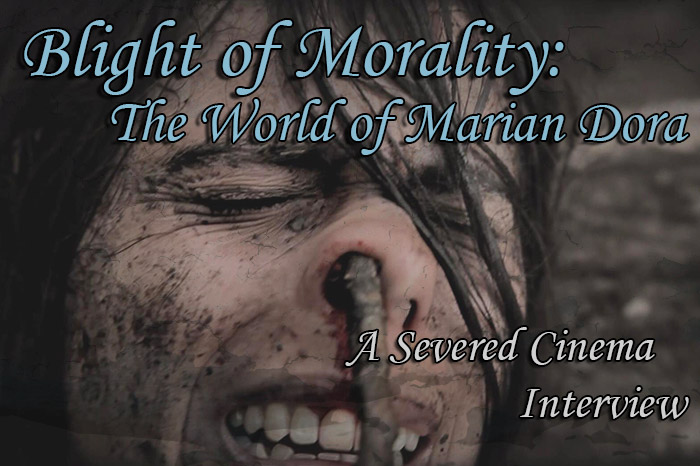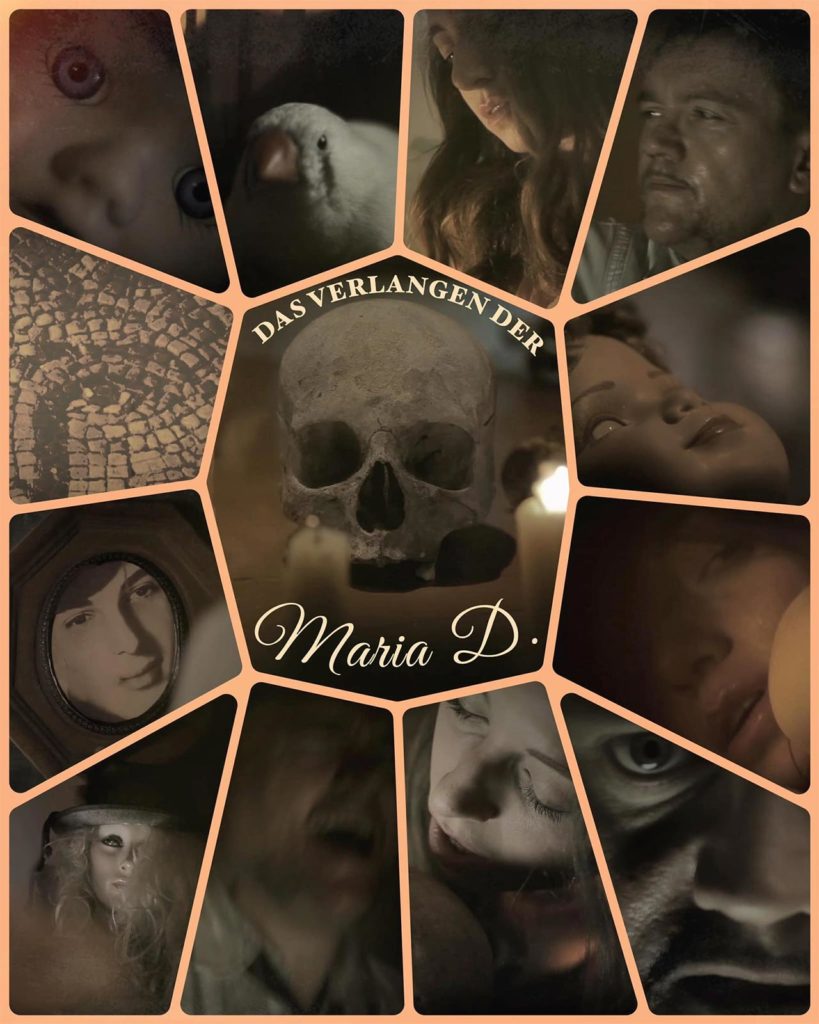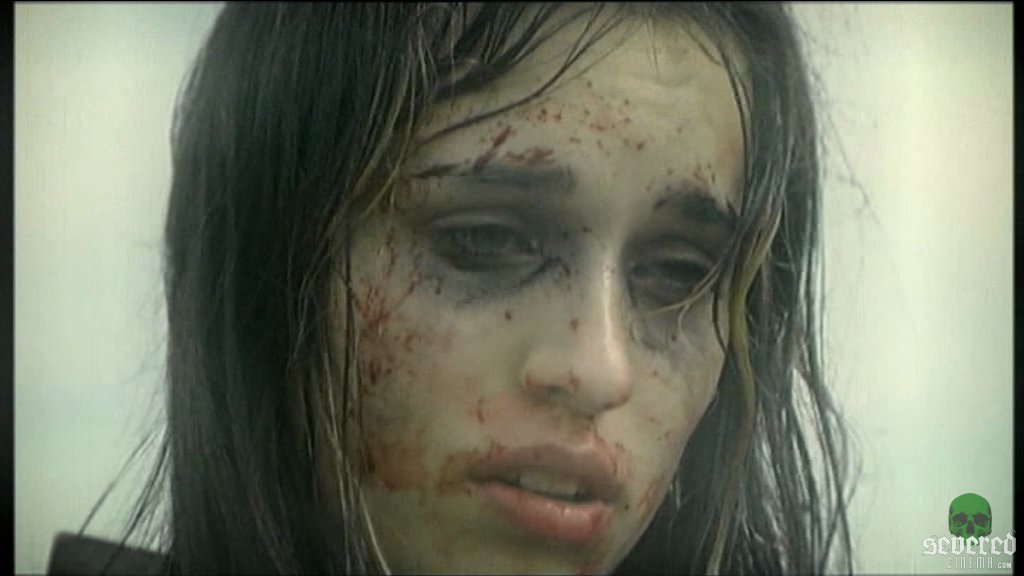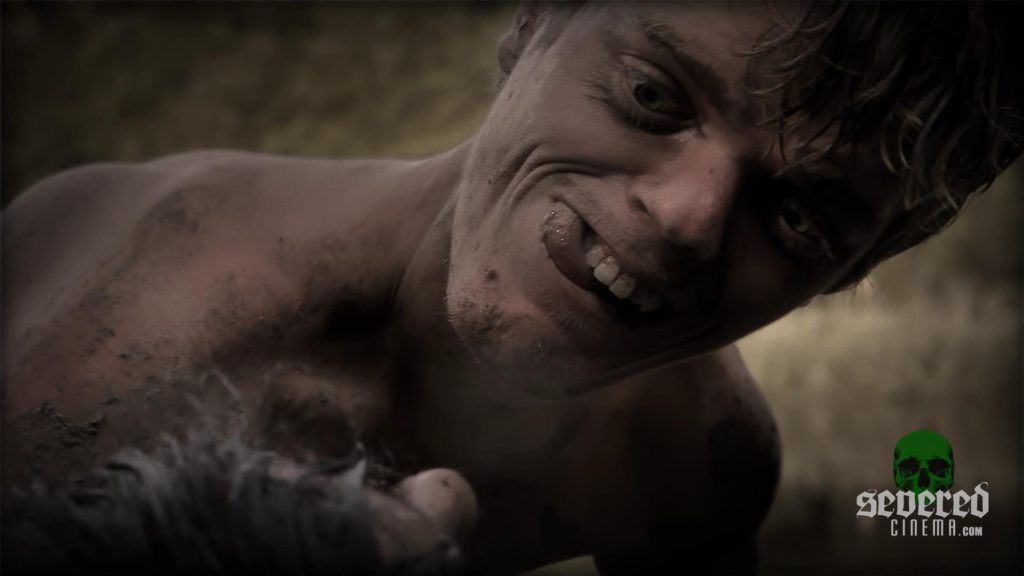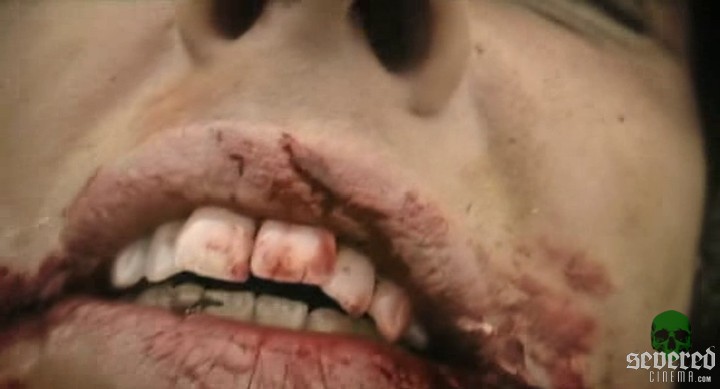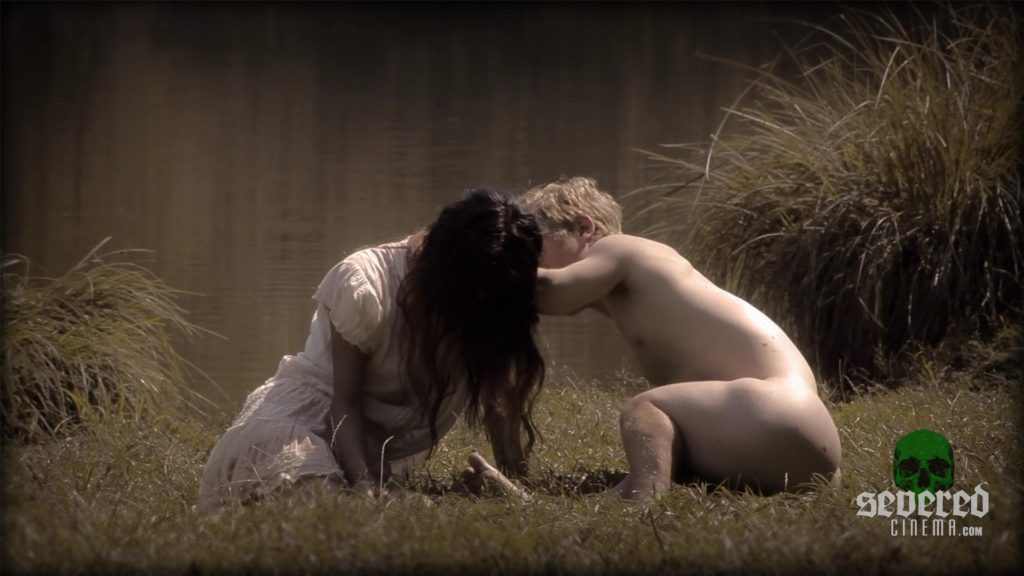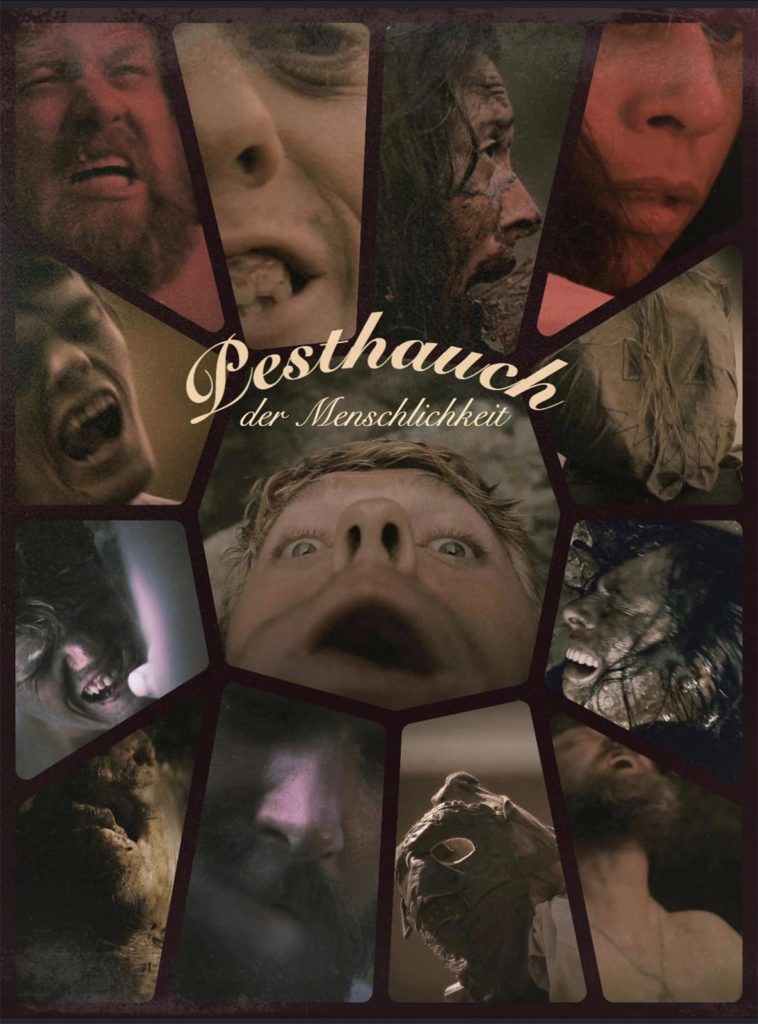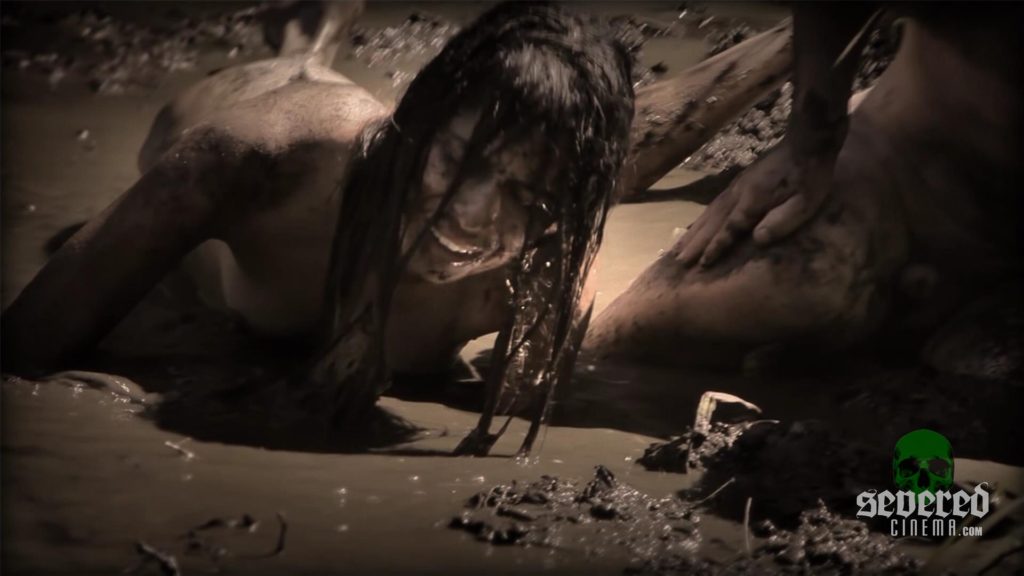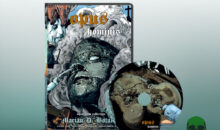Blight of Morality: The World of Marian Dora – A Severed Cinema Interview
Five-years-ago Severed Cinema did an in-depth interview with notorious German filmmaker Marian Dora. With the recent release of his double feature Dead Center of Desire (as Dora himself calls the film), aka The Yearning of Maria D., aka Das Verlangen der Maria D., and Blight of Humanity aka Pesthauch der Menschlichkeit, Dora graciously returns to Severed Cinema for an interview. This is the world of Marian Dora. Part 2.
In your initial interview with Severed Cinema you stated that Debris Documenter is in some ways autobiographical. Do you resonate with the sexual depravity and copious amounts of bodily fluids presented forth by Carsten Frank? Could you elaborate?
Indeed Debris Documentar shows the real person Carsten Frank. There is a lot of intersection between him and me, this is why it is justified to call the film autobiographical. In a way the film addresses the eternal question of underground filmmaking: how far would I go? Is it justified to bring the sacrifice of a human life for my film? Debris Documentar, a small and poor touch of a film, cannot give a clear answer to this, because it ends after the killing of the girl, there is no reflection about the psychological aftermath. I would never dare to give a general answer to this question.
Debris Documentar is, in its own humble way, a commentary of this kind of filmmaking. It was born out of frustration because there had been no progress in the preproduction of The Angels’ Melancholia, and I pleaded for an uncompromising way to bring about the shooting…
You haven’t worked with Carsten Frank since Melancholie der Engel. Was this due to him destroying 30-minutes from the film for fear of prosecution? Could you (allegedly) elaborate on the lost footage? Would you consider working with Frank in the future, or has that ship sailed?
Despite the fact we have much in common, in the end Frank and I had different views about the final cut and the release of The Angels’ melancholia. I made the film as a piece of underground, and I wanted to stay underground. It turned out that there had been no possibility of agreement anymore.
Was the cutting of Anjas’s breast in Melancholie der Engel real?
Yes.
You have mentioned before that Melancholie der Engel was based on a real case. Could you fell us a little about the case?
To my knowledge there is a description of the real backstory you can find in the extras of the American release of that film. I think the name of the label is PCM.
After many delays the double feature mediabook of Das Verlangen der Maria D. and Pesthauch der Menschlichkeit has finally become available to your loyal fans and its beautiful. Was having this release see the light of day a problematic process?
The production and the release of the double feature was definitely a difficult process because of the dubiousness of some persons involved. I think you can find the whole story somewhere on the Internet, from time to time somebody sends me screenshots showing details of the story behind the release.
Actually, the double feature was made 2017 as an underground project, and in the underground the films have been seen for years.
Your latest double feature of Das Verlangen der Maria D. and Pesthauch der Menschlichkeit is a departure from Carcinoma. Would you ever make another film like Carcinoma is scope, where budgetary concerns weren’t an issue?
Carcinoma was a small no budget underground film, whereas the double feature was a small no-budget underground experiment. I wanted to explore what is more appropriate to the concept of underground filmmaking: shooting inside or shooting outside. This is why I made two small films back-to-back: One film inside a flat, the other film outside that flat in the nature. Another idea was to drive the concept of filmish minimalism to extremes. It is nearly impossible to create more reduced scenarios: one film only with one actress in a flat, the other film with three persons walking around in the nature.
The postproduction of the double feature was very simple, too. The editing was very basic, only hard cuts, here and there a crossfading if it was necessary due to the narration, and only very isolated a slow motion for technical reasons if I had an image that lasted only shorter than one second. But no visual effects. That also applied for the sound: there are no sound effects at all, there is only the score. Visual effects or sound effects wouldn`t had fit to the concept of minimal, pure underground films. I only enhanced the life sounds to make everything more exaggerated and grotesque.
Das Verlangen der Maria D. stars the late Shivabel Coeurnoir. In the film, various sexual depravity involving a real human skill and bones are introduced. Did you have trouble getting Shivabel to perform in such scenes? How was she as an actress to work with?
Shivabel was no actress. She was a model. She never acted in a feature film. I had a lot of trouble with Shivabel, she refused to act. When I asked her to show emotions, she denied. She told me that it never happened before that a director wanted her to show any emotions. I tried to explain to her I wanted to show her character as a human being, not as a robot, but she didn’t understand.
But I had absolutely no problem with her performing the scenes with the human remains. Because she understood the fact that everybody watching the film can clearly see: Dead Center of Desire is not a film about necrophilia. At least since the Nekromantik films everybody knows: Necrophiliacs love dead bodies BECAUSE they are dead. But Maria loves Thanos EVEN THOUGH he is dead. That fact was important for me because of three reasons: the first reason is that Buttgereit already had gone through the topic of necrophilia extensively more than thirty years ago. It is not necessary trying to repeat that. The second reason relates to the fact that the Nekromantik films had huge production volumes, for part one a team of people worked more than one year. It would have been an impossibility for me to keep up. But the third reason is the most important: I wanted to avoid dealing with a taboo. Unfortunately, people keep assuming I want to break taboos. Especially this day and age is full of many ridiculous taboos, and I feel it beneath my dignity to deal with them. I never did. All I show in my films everybody saw a thousand times in other film or in reality. However, I am interested in showing things that SHOULD be taboo, but aren’t.
I would like to give an example: maybe it would be a good idea to taboo land consumption. Nobody cares at the moment that nature and in the end every living being find dwindling habitats. Another example: four or five hours after food intake I am hungry again. If I would eat a fried chicken, a living being would lose his existence only for a few hours of my feeling of satiety. This is no justifiable proportion. Why not make eating animals a strict taboo in the future? Or take the fact that from the beginning of social life there is an exercise of power between humans. Maybe it would be a resolution for the future of society to taboo that from early childhood? Showing such “should be taboos“ in an exaggerated, caricature way seems to be much more interesting for me than breaking pitiful taboos. By the way, what I described in the last lines was the concept of Blight of Humanity, the companion piece of the double feature.
In the supplemental features of the mediabook pertaining to Das Verlangen der Maria D., second unit director, Gustav Ljungdahl is interviewed. Herein he makes claims about actor Marco Klammer being out of control during the filming, getting drunk and belligerent, etcetera. Was this method acting so to speak, or was he difficult on set? What is your interpretation?
Gustav Ljungdahl is an honest person and a wonderful filmmaker. He makes great Sci-Fi/Monster/Robot stuff. But working under the conditions of underground filmmaking was a shock for him. Of course, the working on that film was a disaster, and fortunately it lasted not even a handful of days. But having no time to work with actors, the only chance with an underground shoot is to create an atmosphere that enables the scenes you want to film. It is the characteristic of underground filmmaking to include reality during shooting. This is the big difference to independent filmmaking, for example. Therefore I wouldn’t name that “method acting“, a term from commercial cinema.
You’ve previously stated that filming Melancholie der Engel turned into a nightmare. Do you keep in contact with any of the actors from the film?
No.
There is one hypothesis a fan of yours sent me regarding the character of Melanie in Melancholie der Engel being a witch. He mentioned what her period represents in the film, and how women menstruating were not allowed in the fields due to fear of spoiling the harvest. Was there any intension of this character being a witch?
I am able to reflect my work, but not to analyze it. Of course, I know what I had in mind creating that film, but I don’t think it is a good idea to name it. That maybe would narrow down the perception of the viewer.
You are a very allusive filmmaker, using a pseudonym for your work. Without divulging too much of your private information, could you tell us about your upbringing? In the liner notes of the mediabook you mention you worked temporarily in an institution with people with mental disabilities, which gave you the idea of the character Verus in Pesthauch der Menschlichkeit. Could you give the dear readers a little bit about your upbringing/childhood?
There are different reasons not only to work under pseudonyms, but to hide details of the person who made the films generally. One of the reasons — beside criminal concerns — is the wish that the films are able to stand on their own, not influenced by the knowledge about the person who made them and why he made them this way. If I get a request to do an interview like this, I try to be polite and answer the questions. But I myself try to avoid the public and try to avoid public statements.
Did your start into feature length filmmaking come from the films you worked on as assistant director for Ulli Lommel, B.T.K. Killer, Killer Pickton, Green River Killer, etcetera? Can you tell us what it was like working on these films, which are noticeably dissimilar to your style of cinema?
Being assistant of filmmakers like Franco or Lommel didn’t influence my way of working, because at that time I already had my own way. But as a person interested in film history it was a precious chance for me to get access to the way of filmmaking and the way of thinking of such different, interesting artists. With this experience I had the key to understand the films they made in the past, especially in the seventies, the Golden years of culture and of filmmaking.
You have built relationships with such filmmakers as Jess Franco and Ulli Lommel. How did you friendship with Jess Franco commence?
In the year 2001 I joined a film festival in Munich where Carsten Frank had organized Jess Franco and Lina Romay being guests. I was there with Carina Palmer. Franco and Lina Romay saw her and offered her to come to Spain to take the lead in two films made back-to-back. But in the end, only one of the films had been made.
Obviously Lommel has seen your work with Cannibal and possibly more. How are your relationships with colleagues? Have any colleagues seen your films and taken umbrage to the extreme nihilism and graphic cruelty depicted within them?
Lommel lived in his own world, he saw Cannibal because he had to see it. Originally it was his production. But Lommel was never part of the underground. Other underground filmmakers know my work, of course. But I am often criticized of being too superficial and too mainstream. Without wanting to be arrogant, I want to assert that in contrast to some colleagues who only supply the market of the Peter Madsens of this world I am someone who love films…Do your friends and family know the types of films you create? Do you need to keep this side of your life secret?
There are films that can be considered family films, and there are films that can’t be considered family films. Usually, underground films are not family films.
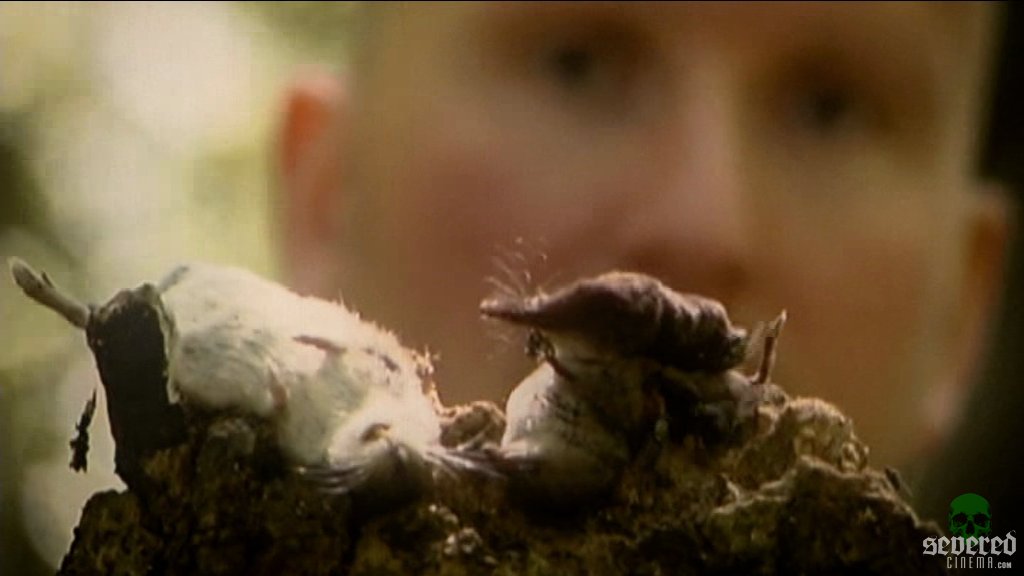
Pesthauch der Menschlichkeit really takes nihilism, to a new level with the depiction of severe human an animal cruelty. For me, the ending surpasses anything in Melancholie der Engel. Was this your goal to outdo yourself?
The Angels’ Melancholia was a much more multi-layered film than Blight of Humanity. It is difficult to compare these films. The following applies for the concept of the double feature films: Not the films themselves had been in the foreground, but the filmic experiment.
In Severed Cinema’s previous interview with you, we asked about the animal cruelty in your films. For which you replied: “It is a part of the specific philosophy of my films to avoid the faking of scenes like torturing animals or human beings…” Continuing you state, “…scenes like that are a declaration that the film you are watching is not made for entertainment.” In the mediabook liner notes you describe that in the last 20-years how 50% of the rainforests are destroyed and 20% of animals have become extinct — a true blight to humanity. Do you feel this statement is somewhat hypocritical of you? In Pesthauch der Menschlichkeit various animals and insects and killed on screen, as well as many piglets are dispatched and brutally mutilated with spears. Why did you feel it essential to kill so many animals for the sake of a movie? Surely the torment and rape of the female character in the film was impactful enough, rather than instigating to the death of innocent animals that you so delicately capture in nature scenery.
Let me tell you, I never killed a human being or an animal for the purpose of a film. Never. I only FILMED people doing it. This is not uncommon for underground films. If you compare a shooting with the My Lai incident, then I am Medina, not Calley. It wouldn’t had been necessary for scientists to perform a Milgram experiment. They simply should have joined the shooting of an underground film. Every shooting is a Milgram experiment.You depict nature with the most beautiful of shots. Particularly in Pesthauch der Menschlichkeit, where certain shots look like a beautiful moving painting. Is there a deeper meaning to your extra imagery of animal cruelty? Or are you more interested in merely pushing the limits of what’s acceptable in an artistic statement?
Let me be a little emotional to answer this question: Everyone deciding to watch an underground film decides against escapism and against entertainment. Underground always means to be confrontational. Therefore, I appreciate that there are people willing to expose themselves to underground. Looking at the truth is not the main problem in this world. The problem is to look away.
Many fans would like to know more about the thought process of Marian Dora. Does morality ever play a factor in your regular life when not filming? Do you ever have remorse for some of the situations you depict with the camera between both human and animal cruelty? How does a filmmaker set morality aside for photographing such extreme situations?
I want to answer your question with a parable: Jacopetti was accused of risking the life of people and for manipulating situations where people found their death, all for the sake of shooting Africa Addio. He answered that his hope is the war in Africa will be stopped when the people see the truth.
Is it justified to bring some sacrifices for the reason to avoid more suffering? It is not possible to find a universal answer, but it is true that the attitude of underground film making sometimes is: In some cases and under certain conditions it can be justified.
I am fully aware: With such an approach it is impossible to make friends. But underground is the wrong place looking for friends…
Shooting such extreme depictions of the nastiness of humanity is central to your storytelling. Do you find catharsis in creating your dark art? Or are you a sadist documenting your fantasies? Are the viewers merely voyeurs?
A film like Blight of Humanity results out of disappointment in mankind, and there is absolutely no doubt that everyone watching this film with open eyes and open mind will understand that fact. I have no doubt at all. I wanted to show the real human condition, therefore I tried as hard as I could to avoid that this main goal would be hidden by the content of the films themselves. To keep an objective look, one strategy was to avoid that a viewer will be too much involved into the films, into the pictures and events, and I included as many elements as possible to tear the viewer out of the films. Mainly in Blight of Humanity with its conception as a filmic farce, but also in Dead Center of Desire, where I distorted the voice of Schroff to Donald Duck to be sure that every appearance of him brings the viewer to distance from what was happening. But I wasn’t completely successful with my strategy. A few years ago, after watching the double feature a viewer complained to me about mistakes regarding the continuity. He explained that Maria in Dead Center of Desire lost in some scenes the wound of the cigarette in her face. I explained that I shot chronologically, and the disappearance of the wound would be a miracle that could only be compared to the weeping Madonna of Syracusa in Sicila. I tried to help him with the films, and a closer look showed that he confounded flashback shots in the final montage.
In Blight of Humanity, he was irritated that the dwarf lost one tooth without having a gap afterwards, and that Marietta suddenly had no stick in her body at the end of the film. I gave him the tooth of the dwarf, which I kept, and by comparing it with his own teeth he realized that it was a molar tooth and therefore no gap could be visible. And a closer look to the film even explained the missing stick. Without any doubt both films HAVE innumerable technical problems, but normally nobody would waste their time to search for them in a no-budget-no-time-underground-nothing. If you are looking for technical perfection, you should watch student films. Typically, student films are made with the focus on the technical side, with a crew and with excellent equipment. You shouldn`t watch underground films. The guy looking for mistakes realized that his perception was a strategy to escape the pictures, therefore I have to admit that I failed my goal.
Mors in Tabula was originally shot as a short film for The Profane Exhibit, coming later next year from Unearthed Films. The original Mors in Tabula played to audiences in 2013 at Housecore Horror Film Festival and later at the Sadique-Master Festival in 2016, which I have yet to see. How was the response of the original at these festivals? Very little can be found of this online. Then later you shot a new short with the same name for the release, which I have seen involving the ill child. What can your fans expect to see when Mors in Tabula finally reaches a wide audience with the release of The Profane Exhibit?
Speaking about the response: You can compare it to the response of the double feature, too.
The reception of my films is, as far I can tell, always the same: lukewarm. And this is the right response to such films in my opinion. Of course, no one can like films with no production values, with innumerable flaws and technical inadequacies. Homemade no-budget stuff made according to the principles of underground filmmaking. But even if nobody likes it, the viewers recognize a certain love for the medium of film here and there, even in such reduced projects.
Is your casting process difficult due to the infamy of the name Marian Dora? As the years go by, and as your status grows, do you find it increasingly challenging when casting?
It is difficult to answer that question. For the double feature I made no casting. The producers sent me the persons who acted in the films. I didn’t know anyone. From Shivabel they showed me only one photo in advance with her face covered by a mask. The guy who played the leading part in Blight of Humanity arrived too late; I had already started shooting. I said only “Hello, please stand here and look like this.“ I didn’t find out his name only months later. It was not relevant.
The double feature was a filmic experiment, nothing more. I was not really interested who had been in front of my camera…
But nevertheless, I am thankful for the willingness of the participants, of course.
You recently have been shooting with Marco Klammer from Das Verlangen der Maria D. and Thomas Goersch from Voyage to Agatis (my favourite film of yours). Could you share a little about what the next film(s) we can expect from you are?
After watching Wiesner’s “Shooting underground” I had the feeling it would be fair to give Marco Klammer the opportunity telling his memories of the events that happened during the shooting of Dead Center of Desire, but Klammer had not been in the condition to get through it. Now he agreed. Because I felt I am not the right person to interview him in front of the camera, I suggested that Thomas Goersch will do it. And because Goersch is an interesting character and an actor with a unique filmography — he worked with Carl Andersen, Malga Kubiak, Lommel and other interesting filmmakers — now it is much more than an interview. It is an all-encompassing conversation about film, life, and desires.
Bodily fluids are a central theme in your world of cinema. Where does the fascination with excrement come from?
Imagine the situation: You make a film without any time, without any money, and without any possibilities. Underground filmmaking simply. The only thing you can use is the body of the actor, of course. This is why I routinely show bodily functions. What you see is nothing special, it is everyday occurrences. Here I pay attention to keep the right measure. For example, I show in every film more often a person eating, than a person emptying the body. Oddly enough people speak me about the body emptying scenes, but not about the eating scenes. There is obviously an imbalance in the perception of some people. I can only speculate about the reason.
Do you have a movie in your filmography that is a favourite of yours? Conversely, do you have a film you regret making, or tat you like least?
Obviously, The Angels’ Melancholia is the most complex and profound of my films. Regarding the production volume, Cannibal and Carcinoma are in the middle field of typical underground films, with each one-week shooting. Debris Documentar, Voyage to Agatis and the double feature films are the very small ones.
I have to accept that these films are how they are. They are always a mirror of the circumstances they had been made, and not the mirror of what I had in mind when I planned them.
The music in your films is beautiful and is as important or more than the characters the films depict. Do you ever plan on releasing the soundtracks of any of your films on CD, digital, or vinyl?
To be honest, I am not in the position to talk about music. Nevertheless, I will give a longer answer to that difficult question.
I am a man of film. I am not a man of music. Indeed, I never listen to music, unless someone asks me to do so. And I never bought a music CD in my whole life.
Regarding my own compositions I did for my films: I am not Johann Sebastian Bach. The melodies I created for my films are very simple, they are on the level with the melodies of children’s songs or a hymn you hear in the church. Everybody can come up with such melodies in ten minutes. In the same moment I create the scenario of a film, I have the music for the film in my mind. I had some months of piano lessons when I was a child, more than 40 years ago. Because my melodies are very, very simple, I am able to play it after rehearsing it some time. If you think you don’t have the fingers for doing that, then ask your neighbour. In every street you will find at least three people who are able to play one or another musical instrument. They will play it better than you. Record it with your cellphone. If you hear piano pieces in my films: they are all recorded with the cheapest cellphone you can imagine. I put it besides the piano. If you have a musician in your acquaintance — all the better. He will do it even better than your neighbour.
Even if your music is poor and can not stand for its own, it will fit to your film. If you are not schizophrenic it has to fit, because it comes from the same mind as the rest of the film. It doesn’t matter if you make the music in advance or after the shooting. It will fit in one or another way. Sometimes people assume I would edit the films to my music, but I never did, unless I make a music clip or a trailer. Nevertheless the music follows the editing or the movements of the actors, more or less… Here and there it doesn’t follow, but all in all it is okay. This is why — as a filmmaker, not as a musician — I tell everyone who wants to make a film: Always find your own melodies. There are some film musicians working for free, but the melodies of a stranger can never really fit to your film. Do it on your own, even if the result seems to be poor. After watching Blight of Humanity, a musician told me that my music is completely out of rhythm. Of course it is, because I had no metronome when I made it. But it doesn’t matter, because the pictures which are accompanied by the music are full of flaws, too. This is underground filmmaking. How could one have a claim on quality?
Speaking about films, I have an opinion. If you tell me that a film I like is a piece of trash, it won’t influence my opinion a millimeter. But speaking about music, I have absolutely no opinion. If you tell me the German national anthem with its simple melody is musical rubbish, I will believe you, even if I think it is suitable for its purpose. If you tell me it is a musical masterpiece, I have to believe you, too. Once a musician told me, the Ortolani music of Cannibal Holocaust is a piece of shit and compared it to the music you can hear in shopping malls or in elevators. I have to believe him, but for my feeling it fits perfectly to the film. Obviously, the quality of music is not relevant when music is used to comment on a film.
Back to Das Verlangen der Maria D. and Pesthauch der Menschlichkeit. Did your budgetary restraints affect the visionary outcome of these films?
With the exception of the extended flashbacks, which we shot on the morning of the first day of shooting, the complete film took place in an appartement. Only one actress and four rooms. No difficult scenes. Nearly no dialogue. And a very, very slow pace, a little bit like a Jess Franco film regarding the slowness. Nothing really happens in this film. After that days we left the house and shot the other film at a nearby lake right next to the street. If you are bored of the film you can count the cars passing by, you will find it in nearly every scene. As I said earlier, the experiment had been in the foreground, not the resulting films. But even under this premise once again that films are only a shadow of what I had in mind to do. But apart from that fact the concept of minimalism was an important principle of that experiment. Compared to Dead Center of Desire, the second film of the double feature, Blight of Humanity, is even more reduced and more minimalist. This film doesn`t even tell a story anymore. The film just plays through a situation. It was important to me NOT to tell a story. The reason is as follows: Look at The Angels’ Melancholia, a film that I made 15-years-ago. Even today people ask me a few questions here and there related to the story the film tells. But the story wasn’t the main reason I made this film, much more I wanted to show certain human behaviours and mechanisms. Because of this, I realized that a story can sometimes cover up more important elements. Therefore, it was clear that for Blight of Humanity I had to avoid telling a story. But there was another element of minimalism that was even more essential for me: I tried to avoid any characterization of the three persons you see in that film. There shouldn`t be told a personal history, and there should be no motivation seen behind their acting. I realized that it is very hard to avoid any characterization if you are with your camera very close to the persons for a few days.
To explain why this withholding background information was so important for me, I have to go further: Some years ago, I spoke with person I know for a while about a film. I can`t remember exactly what film we were talking about, but it could be that it was Uwe Boll’s Stoic. The person told me that he wasn`t impressed by that film at all. I wondered why not, because it is a recommendable movie. He answered that the film leaved absolutely no emotional traces to him because he did not learn anything about the persons in the film, about their history, their character, and their motivations. I simply couldn`t believe what he was pointing out. He couldn`t mean that seriously. This statement blew me away! That would mean that an emotional assessment of what happened would be depended on knowledge of background information, which of course is an absurd assumption.
Take any well-known crime, for example the mistreatment of a 23-years-old female student in India 2012. Six men raped and injured her, and she died later to her injuries. The four still living perpetrators consequently had been executed last year. Even if you don`t know anything about that girl, everyone should be able to evaluate this incident emotionally. Everybody can imagine the person and the live of a 23-year-old female student. And everyone should be able to imagine the problematic characters of the rapists. And for the motivations: They did it because they had the opportunity to do it at this specific evening. No one needs any further information about the persons, it is simply not necessary, the knowledge of the act itself should be enough.
I remember once driving through a small village where I saw an old, fat farmer’s wife hitting heavily a sheep with a stick. It was not necessary to evaluate emotionally that situation, even without knowing the background of that incident the problematic character of the wife was evident. And I felt sorry for the sheep even without knowing anything of it.
If you think you always need background information, you shouldn’t care about any suffering in this world.
Or could it be that this is one of the reasons why there are so many problems on this planet? Because people don’t care about the suffering of anonymous creatures?
I strictly refuse this way of thinking. This is why there mustn’t be any explanations in the film. No back-story. Only the act and the nature of man itself. That’s enough. No further identification. Keep distance.
Of course, I immediately withdrew from this person who talked such nonsense…
For aspiring directors out there, what camera did you use to shoot Das Verlangen der Maria D. and Pesthauch der Menschlichkeit?
I used no film camera, of course, but a DSLR photo camera, and for the flashback scenes of Dead Center of Desire I used Video 8. Some scenes I filmed with my cellphone when the battery pack of the DSLR was empty.
But allow me to add a few more words in addition to answer that question: Some weeks ago, I filmed a conversation between two actors in the park of a small town, as I mentioned above. The actors started to make photos with their cellphones there, compared their pictures with each other and pointed out, the pictures looked like typical “Marian Dora pictures.” I told them that there are no “Marian Dora pictures,” and that there is no such thing at all. You simply have to go to such locations, and you will get such pictures automatically. There is no secret behind it. Just leave your room, go outside to the right place, and you will get the images you want.
There is only one small trick, if you want: use the cheapest equipment you can get. Even if the result is a technical disaster: the flaws will make the images more interesting. But of course, this is a matter of the own taste, too.
The finale of Pesthauch der Menschlichkeit and what Marietta Fiori’s character goes through, is incredibly realistic looking, and brutal beyond description. Was this a tribute to Cannibal Holocaust?
By working in the nature, even it is only a small lake besides the car road, there is no avoiding that one or another image resembles in a poor way some details of a film taking place in the wilderness. But with nothing in your hands you can’t even dare to even pay homage to Deodato’s masterpiece.
Who did the effects for the film?
With the lack of time, money, and possibilities I always choose themes that do without special effects. But I am not at all uninterested of special effects. I enjoy Ray Harryhausen films, for example. Especially his Sindbad films, but Jason and the Argonauts is great, too.
I am fully aware that viewers are not interested in quiet, minimalistic, and slow films like the double feature, but in loud and effectful films as you can find in the field of independent or in mainstream films.
Two months ago, the double feature had been screened at a small German film festival. I haven’t watched other films in the context of this opportunity, but I saw a trailer of one of the festival films, it was called Death Ranch. It was a massacre! Dozens of persons had been killed, dismembered, shot in pieces, and the blood splattered across the screen. This is the stuff that people want to see, of course! But, besides that, in the entirety of cinematic work of the world there is space even for such experiments like my small double feature.
Do you have any plans for the holiday season? Does Marian Dora celebrate Christmas?
Watching my films you maybe recognized that I have a foible for atmosphere and for rituals. The last days of a year always have a special kind of atmosphere, and I hope I will find the time to perceive it…
It is with much appreciation to Marian for taking the time for a second interview with Severed Cinema. Thank You


